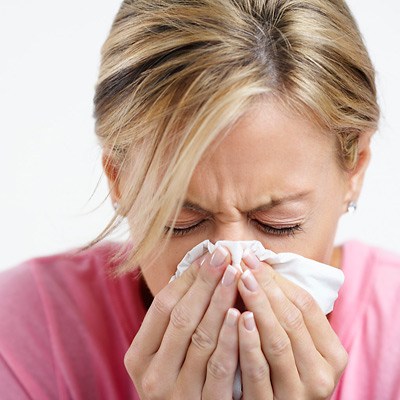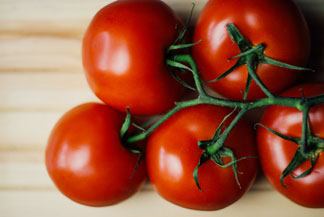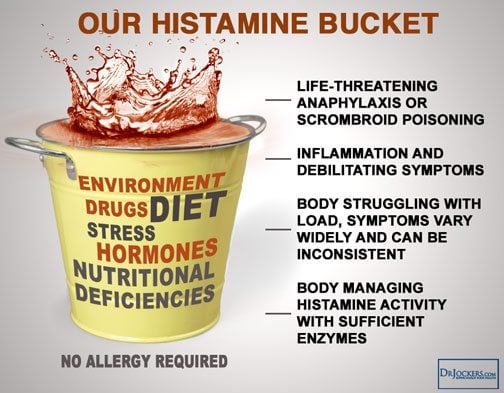Did you know that histamine is the major cause of chronic idiopathic urticaria (CIU) – commonly known as hives?
Regular allergy sufferers are familiar with histamine through antihistamine drugs, but hives sufferers may not be aware that histamine intolerance is a major culprit in their condition.
Histamine Intolerance
Hives, histamine, and allergies are all connected to the inability of our mast cells to metabolize ingested histamine. Diamine oxidase (DAO) is the main enzyme responsible for controlling histamine and should that enzyme be deficient, havoc can erupt in the form of Histamine Intolerance.
Histamine intolerance is a common but rarely discussed or diagnosed disorder. This is because histamine moves in our bloodstream and can affect every part of the body – particularly gut, brain, lungs and the cardiovascular system, making specific medical diagnosis nearly impossible. The complex and little-addressed relationship between food, allergies, and histamine – our allergy trigger – is ignored by Western medicine. As a result, medical practitioners resort to prescribing drugs such as Prednisone, Atarax, or Levocetirizine (Xyzal) to control hives. All of these drugs have damaging side effects not the least of which is elevating cortisol and weakening our immune system.
I know. I’ve tried them all; none of them worked. I suffered from CIU for over two and a half years and finally gave up on prescription drugs – and doctor’s advice. It was a debilitating, soul-destroying sojourn with no help in sight. Even when I didn’t have hives, my skin burned and itched and simply putting on a light cotton t-shirt would be unbearably painful. Life as I knew it, ended. I lost 25 pounds, suffered severe hive attacks almost daily and went into anaphylactic shock at least once a week. It seemed like everything I ate caused a hive attack. I carried an epipen everywhere and was in every emergency room in New York City – more than twice – until I finally
made the connection between food and my symptoms.
Our Second Brain
Our ongoing battle with histamine is reflected in myriad symptoms such as migraines, IBS, congestion, extreme mood swings, insomnia, eczema, and of course, hives. None of these conditions can be cured with drugs. It’s a gut problem that needs to be addressed at the source. It’s unfortunate that Western medicine consistently fails to take into account how our bodies function as a complex synergistic organism. The truth is our gut rules our health. Our guts are often referred to as our “second brain” and recent studies show that our overall health is dictated less by our brain and more by our enteric nervous system or our gastrointestinal tract.
High histamine levels also contribute to elevated feelings of angst and intense mood swings. Allergies can literally change you into another person – in my case, a demon.
The only solution is to take complete responsibility for what goes into your body. If you’re fighting hives or severe allergies, there are immediate steps you can begin for immediate relief.
Eliminate Foods High in Histamine
Many foods that are touted as being “healthy” are loaded with histamine and can destroy someone who is histamine intolerant. Nightshades are at the top of my list of “foods to avoid.” This family includes potatoes, eggplant, and tomato. Nightshades produce a natural pesticide called glycoalkaloid. It can annihilate worms and insects, but it blocks enzymes in humans that control our nervous systems.
Glycoalkaloid toxicity can be found in people who eat a lot of potatoes and Gastrointestinal problems are at the heart of allergy. Spinach is another problem; it contains massive levels of salicylate, a natural preservative. Salicylates are known to cause severe allergic reactions. Many people who suffer from allergies have an intolerance to Salicylates [aspirin is a derivative]. Chronic hives are only one of the symptoms of Salicylate toxicity. Avocados are another problem. One allergy they can produce is a “latex-fruit allergy” and the other is birch pollen. Both can result in hives and anaphylaxis.
So eggplant, tomato, spinach, and avocado – foods I practically lived on – were eliminated. [Tobacco is also a nightshade so if you’re allergic to tobacco smoke – as I am – it’s a good bet that potatoes and other nightshades will be a problem]. Chocolate and coffee were the next to go. Sugar is another culprit. This is a tough one since so many foods have sugar added, so you have to read labels carefully.
In general, stay away from processed food altogether. Smoked, processed, and fermented meats like bacon, pepperoni, and salami are big no-nos. Anything fermented will cause histamine to escalate; histamine is produced during fermentation This meant that my second love, cheese, had to go along with any product that used vinegar.
Probiotics can make it worse
The probiotic I’d used for years suddenly began causing instant hive attacks. After research on the web, I discovered that not all probiotics are created equal. Many will make allergies and associated symptoms worse, while others will help. Lactobacillus casei and bulgaricus will escalate histamine production while Bifidobacterium infantis, B. longum, and Lactobaccilus Acidophilus will degrade histamine and help your body fight inflammation. Since Lactobacillus casei, and Lactobacillus bulgaricus is found in nearly all yogurt, eliminating yogurt is necessary. You’ll also need to stop all sodas; they’re loaded with sugar and additives. Benzoate, a common preservative in soda, has been implicated in hive attacks and other allergic reactions.
One more thing to consider is that all alcohol will add to your histamine level so proceed with caution. This excellent chart compiled by Dr. Janice Vickerstaff Joneja of the MASTOCYTOSIS SOCIETY in Canada, provides a clear list of foods to avoid and foods that will help allergy and hive sufferers.
I’d been gluten free for over three years so I wasn’t worried about that, but it did take some ingenuity to figure out what I could eat. So what’s left? Lots of things evidently, that I had failed to consider. Yasmina Ykelenstam, The Low Histamine Chef, literally saved my life. Her website is a goldmine for those suffering from autoimmune or allergic symptoms and she offers several excellent cookbooks. I started with The Anti-Cookbook: Anti-histamine and Anti-inflammatory Recipes for Health.
Eat These Things
Kale, zucchini, red onion, garlic and ginger are huge immune boosters. I lived on home made soups for a year using combinations of split yellow pea, fennel and carrots, or sweet potato, red onion and chick peas. Mashed cauliflower stood in for potatoes, but roasted cauliflower is also delicious and a snap to prepare. Finally, though I’ve never had a problem with seafood, I now avoid all shellfish and nuts. Better safe than sorry.
One more thing: Food should be eaten immediately after cooking – particularly meat and fish. Deterioration begins soon after preparation and histamine levels escalate due to microbial action. Don’t eat leftovers. It’s a tough path to follow, but once you begin to see some relief, you’ll never revert to your old eating habits.
Other Allergy Culprits
Many herbs and infusions that are often advocated as having beneficial effects can wreak havoc if you are allergic to that particular plant family. Chamomile, for instance, is part of the family Asteraceae. I found out the hard way that I’m highly allergic to Chamomile, so I avoid it like the plague along with any teas, or skin care preparations that use it as one of the ingredients. Holy Basil tea, on the other hand, has proved to be an amazing anti-inflammatory and I have both pills and tea on hand all the time. It has a calming effect and the tea is delicious and sweet. Holy Basil is part of the aromatic Lamiaceae plant family that also includes mint, rosemary, sage, savory – all herbs I can tolerate. Many medications will inhibit diamine oxidase [DAO] necessary for regulation of histamine. NSAIDs such as ibuprofen and Aspirin can cause histamine levels to elevate, but there are other offenders.
Finally, blood work revealed that I was severely deficient in D3. I didn’t make the connection, at first. I stumbled across research that proved hive sufferers are commonly deficient in vitamin D3. A study found that introducing (4,000 IU/d) into diet demonstrably reduced hive attacks.
Only after months of exhaustive research did I arrive at a way to minimize my symptoms and ensure that I was in control of my health. Balancing your system and bringing histamine levels down is not an easy task; it does take time, but eating the right food will work. Once you’ve reached a point where symptoms have abated and your overall health has improved, you can add small increments of food that you love. Now I can eat some blue cheese and I’ll occasionally add a tomato to a salad. The trick is not to over do it and always be aware that what you put into your body will eventually be reflected in your overall health.
One Final Word
Never self-diagnose. If you’re suffering from repeated episodes of hives see a physician immediately. They will be able to test for any underlying causes. This should be your first course of action. However, if you’ve been to a battery of physicians including an Endocrinologist, a Gastroenterologist, an allergist and a Dermatologist, plus your regular PHP and they’ve all come up with nothing, then it’s time to revise your diet.















































